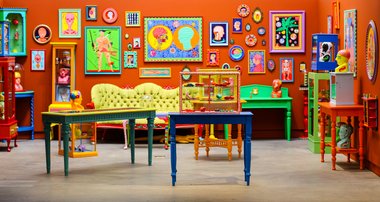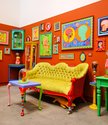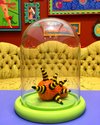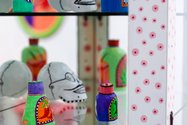John Hurrell – 22 October, 2018
In the white bay, in a cabinet of little white remedial jars, we can read some of the labels: Jack rabbit poo, Bile diluted with wine, Spider in the butter, Tincture of human navel, Fasting spittle drops, Gripe water for fen fever, Mellified man, Blood jam, Urine from a public latrine, Pus, Tooth tartar. Nearby we can also see skulls that have tattoos or scrimshaw. Some even wear spectacles, have fob watches for eyes, and have moustaches.
Christchurch
Nicola Jackson
The Bloggs
22 August - 18 November 2018
Dunedin artist Nicola Jackson has been making her paintings and brightly coloured papier mâché sculptures for almost four decades now and the more she refuses to change, the better the obsessive components of her installations look: her odd looking self portraits, body organs, images of bones and painful complaints, and bottled Victorian cures, are becoming profoundly contemporary.
Usually Jackson exploits saturated hues as an expressive brand, in the mode of Central American folk art, covering mâché viscera, cut open heads and severed limbs or torsos, alongside squeaky white skeletons and skulls. They are like mini Niki de Saint Phalles, but more diagrammatic with more detail, with lots of written (drolly funny) captions. And although they look celebratory, because death is ever present and religion is absent, they remain creepy. If you laugh, you do so nervously.
This show is a version of an exhibition Jackson had in Uxbridge, Auckland at the Malcolm Smith Gallery (a large single room) over Christmas. Now at CoCA in Christchurch, Jackson has two bays on the Mair Gallery floor, but at the Gloucester St end of the building, above the entrance. On the walls leading to them are masks, 24 on each side in rows, that reference other cultures. They are museological and theatrical.
With the bays, one has white walls, the other orange; one with medicines, the other body parts showing medical ailments; one with display cabinets, the other drawing room furniture that includes laden tables and cases—with a bright lemon yellow crocodile under a divan. Both bays have lots of curiosities, though the orange room is much more crowded.
In terms of colour, one is very restrained, the other wild. Both have portraits of organs on the walls with some symbolic animals and medieval creatures, but in the orange bay the painting layout is much denser. Some paintings have amusing captions like “A Loose Tongue” or “This is an ‘I’m not scared of anything’ Portrait”.
In the white bay, in a cabinet of little white remedial jars, we can read some of the labels: Jack rabbit poo, Bile diluted with wine, Spider in the butter, Tincture of human navel, Fasting spittle drops, Gripe water for fen fever, Mellified man, Blood jam, Urine from a public latrine, Pus, Tooth tartar. Nearby we can also see skulls that have tattoos or scrimshaw. Some even wear spectacles, have fob watches for eyes, and have moustaches.
Jackson deserves to be better known than she is. There is more to her work than fixated thematic repetition, because she encourages us to think about how the mechanisms of our bodies—their range of functions—are represented. In her case, she bombards our visual senses, while suggesting that we wonder about those very same ocular (some would also say tactile) sensations—how what is ‘outside’ in the world beyond becomes ‘in’—in terms of our immediate experience. In our current digital age, when electronic devices are more regularly becoming incorporated into our bodies, this gadget-free examination has much value, while our corporealities remain comparatively simple.
John Hurrell





 Advertising in this column
Advertising in this column Two Rooms presents a program of residencies and projects
Two Rooms presents a program of residencies and projects



This Discussion has 0 comments.
Comment
Participate
Register to Participate.
Sign in
Sign in to an existing account.